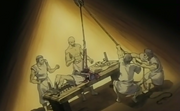The Watanagashi Festival (綿流し祭, Cotton Drifting Festival) is the largest celebration of the year for the rural village of Hinamizawa. It takes place on the third Sunday of June and gives thanks and praise to the village's guardian god, Oyashiro-sama. Two versions have been practiced through the ages.
Origin[]
The festival began centuries previously as the Watanagashi (腸流し), or Intestines-Drifting Festival. It was a time to cast off sins of the villagers by sacrificing them with the blood of a living human. Said human sacrifice would be publicly

tortured using the tools in the Furude Shrine in a very specific process (which notably involved putting nails through every joint in every finger of the victim) before finally being killed by the priest or miko, who gouges out the victim's stomach and intestines with a large, hoe-like dissection tool following an intricate dance. The corpse and its severed intestines would then be thrown into the river and wash away, symbolizing the "drifting away" of the people's sins with the victim's innards.
In modern times, however, the true Watanagashi became viewed as too violent and cruel to be practiced. Instead, the villagers began practicing the modern Watanagashi based on a similar concept by changing the first character of the festival name, Wata- (腸), meaning intestines, with the homophone, Wata- (綿), meaning cotton. Thus was the Cotton-Drifting Festival born. Everyone in the village would contribute old coats and furniture to the village to be gutted for their leftover cotton. Said cotton would then be sewn into a large futon which would take the place of the traditional living human. On the night where the human is traditionally subjected to the intestine gouging, the priest or miko would perform the dance and instead use the hoe to cut the futon and gouge out the cotton in place of intestines. Each villager then takes a small amount of this cotton and sets it adrift on the river to absorb and "drift away" the sins and sadness of the villagers.
Application[]
One specific past use of the true Watanagashi has been confirmed and explored in detail. Hanyū was sacrificed centuries before the start of the series by her own daughter Furude Ōka, after Hanyū offered herself up. Her unique horns had led the village telling her, and eventually convincing her, that she was a demon god unworthy of life. She wished to die to escape the world and carry away its sins. When her daughter sacrificed her, she became a true god, named "Oyashiro-sama" by her daughter.
Although largely unused in modern times in the public's eye, knowledge and practice of the true Watanagashi has been passed down in the Three Great Houses of Hinamizawa. The Sonozaki family even keeps a basement full of Watanagashi torture devices to punish or even kill those who oppose them.
The following are specific key applications throughout the series:
- In Tatarigoroshi-hen and Minagoroshi-hen, the Sonozaki family catches Rina/Ritsuko stealing money from their male relative. In revenge, they kill her in Watanagashi-style and throw the remains into the river in a bag. In Tatarigoroshi-hen, this is the bag found by the landlady at the beginning of the chapter.
- In Watanagashi-hen and Meakashi-hen, Shion uses the Watanagashi torture/murder tactics to kill Kimiyoshi and threatens to use them on Satoko and Keiichi; the former dies during the torture stage from blood loss, while the latter convinces Shion to stop by reminding her of her lost love.
- In Meakashi-hen, it was revealed that Shion had been subjected to torture via ripping her fingernails out Watanagashi-style in 1982 to pay for her "crime" of returning to Hinamizawa. Mion later subjects herself to the same punishment, unwilling to let her sister accept all the blame.
- Furude Rika will be captured by the Yamainu shortly after the festival in all but two timelines, rendered helpless, and murdered Watanagashi-style at the Furude Shrine by Takano Miyo. In Watanagashi-hen and Meakashi-hen, she instead dies in a failed attempt to save Shion from Hinamizawa syndrome.
- In Nekodamashi-hen's fifth loop, Hōjō Satoko declares that Oyashiro-sama appointed her as his new priestess in a revealation and performs the Watanagashi ritual on a fully conscious Furude Rika in their house, with the ritual hoe.
Role[]
The Watanagashi sacrifice of Hanyū in the distant past gave her her god-like power to restart time, which is the power behind the eternally repeating June 1983. This is the premise on which the arcs in Higurashi no Naku Koro ni are based.
In the current time of Higurashi, the coming Watanagashi festival is viewed by the villagers with both excitement and apprehension. This is because every year for the past four years (1979-1982 ), one person has died and one person has gone missing either on the night of Watanagashi or the day immediately after. While the truth behind these occurrences is explored in Matsuribayashi-hen, it is largely blamed by the villagers on the Curse of Oyashiro-sama, who is angry in recent years at those who sought to either leave the village, or those who supported the Hinamizawa Dam Project (For example: Hōjō Satoko's parents).
Aside from playing a key role in both the distant and recent past of the series, the Watanagashi festival is notable for the role it plays in June 1983 as the turning point of each arc. In each world on the night of Watanagashi, two deaths will always occur: Tomitake Jirō (clawed at own throat and bled to death) and Takano Miyo (supposedly found as a burned corpse in the mountains). These murders cause one member of the cast, who is already experiencing delusions, to eventually descend into full-blown paranoia, with tragic results.
Behind the scenes[]
Due to the strong "ritual impurity" taboos regarding death in Japanese religion and culture, the concept of human sacrifice in a Shinto ritual is not only violent and cruel, but also blasphemous and profane, similar to Western depictions of Satanism.
